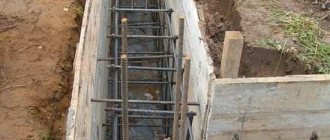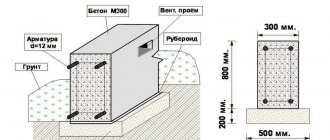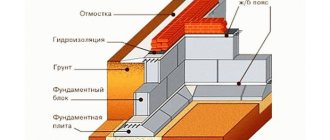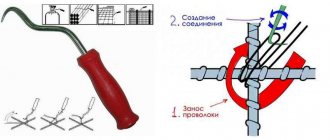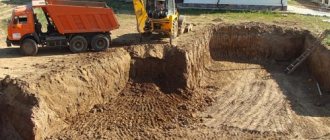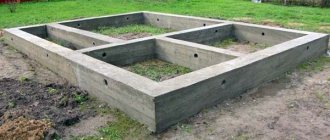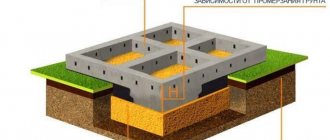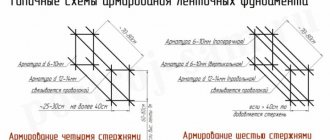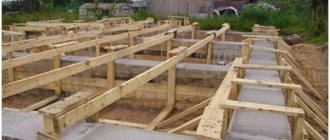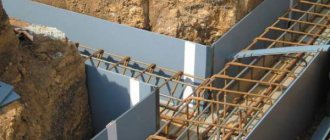Building a house from scratch is an expensive business. Almost half of the funds are spent on the foundation. This is logical, since it is the basis of the house, characterizing it. Sometimes these funds are not enough, so you have to resort to various tricks. If everything is done correctly, construction will cost 20–25 thousand rubles less. What is it about? About pouring the foundation into the ground without formwork. Working with formwork is simple and effective, but the process can be completed without it.
You need to understand that a foundation without formwork is like painting an unprimed wall. It seems to save money, but there is a risk of problems with operation. What to do? Is it possible to build a foundation without formwork? Let's find out.
Purpose of formwork for the foundation
What role does formwork play in our case? It is logical that if a lot of money, time and effort are spent on its creation, then it is an integral part of the structure. One cannot but agree with this. It allows you to obtain the calculated characteristics of the base tape. Formwork is the above-ground part of a structure made of boards, panels, metal sheets and other materials. It forms the base of the building.
Here are the benefits of using foundation formwork:
- A perfectly even and regular geometric body of the required dimensions is formed. Thanks to this, the load is evenly distributed over the foundation, and there are no weak areas.
- Due to the formwork box, it is easy to fix and correctly position the reinforcement bars inside.
- It ensures the accuracy of installation of the heat-insulating and waterproofing layer, as well as their quality.
Note! The main task of the formwork is to maintain the concrete solution in the above-ground part without changing the foundation strip until it finally hardens and gains its strength. An ideal ribbon configuration is formed above ground level.
So it turns out that you can’t make a foundation without formwork? Not really. If you manage to fulfill all the requirements (properly lay the reinforcement, make a level trench and accurately lay the waterproofing layer), then it is not needed. There will be no basement, but for small and light buildings this is not required. Is foundation formwork necessary in such cases? No. It is enough to dig a trench and pour concrete into the ground. In this case, the formwork will be the walls of the pit themselves.
Pouring the foundation
It's time for the finishing stage. You will need a lot of concrete for this job. There is an important point that determines the reliability of the future foundation. The whole point is that the filling must be done at one time, evenly. For example, you finished knitting the reinforcement and installed it late in the evening. This means you shouldn’t bother with pouring, as you may not be able to finish it before the start of the night. You will have to do one part today and the other tomorrow. This way a seam is formed and the tape will not be so monolithic.
That's why you need to wait until morning and pour everything at once so that the concrete doesn't have time to dry out. It is mandatory to compact the concrete. Filling is carried out to the desired level. After which the surface is leveled. Finally, cover the foundation to protect it from rain.
Advantages of a foundation without formwork
Despite the riskiness of the matter, if such a foundation is poured correctly, it will bring a lot of benefits. Let us immediately note that a foundation without formwork does not provide for the creation of an above-ground part, called a plinth. In some cases this is irrational, for example, for regions with harsh winters. But there are also advantages:
- Reduced price for foundation installation.
- Less labor costs.
- Reduced construction time.
- It is possible to dismantle the structure without affecting its base. The foundation can be used for further purposes. This is an ideal solution for structures that have been used for some time.
Refusal of formwork is rational even for loamy soil. And laying the foundation under the soil freezing line will help eliminate cold pushing and negative phenomena completely or partially. You can make a foundation without formwork with your own hands in Russia using the following steps:
- Digging a trench for the foundation according to dimensions.
- Cover the outer sides with film.
- Creating a sand cushion at the bottom of the trench, in a layer of 5 to 10 cm.
- Strengthening the structure with reinforcement in two layers (bottom and top). The process is called reinforcement.
- Directly pouring concrete mortar into the prepared trench.
There is one caveat: to fill the foundation with or without formwork, it is important to choose the right brand of cement. For such work it should be at least M300. It is recommended to use M400. This is exactly what experienced professionals do to ensure that the foundation lasts a long time and does not collapse.
Some foundation parameters
The geometry of the base will be different. It all depends on the consumer's requirements. There is no standard, so the approach is purely individual. It all depends on the mass of construction, type of soil, etc. However, there are some general provisions that will help you navigate.
- The depth of the foundation without formwork should be below the freezing point of the soil. In addition, the weight of the building is taken into account. Typically the depth ranges from 80 to 100 cm.
- The width of the foundation strip, respectively, of the trench will be equal to the thickness of the walls of the building plus a margin of 20–30 cm. It is possible to increase the trench, but making it smaller is not allowed.
- As in the case of a strip foundation, a sand cushion is laid at the bottom of the finished trench. Its layer is 10 or 15 cm. Then exactly the same layer of gravel is made.
If we talk about the general structure of this foundation, then it is practically no different from a regular strip foundation. The only thing that gives it away is the lack of formwork. Otherwise the technology is identical. Under what conditions can this economical base option be used?
Pouring the base without formwork - recommendations
If the soil in the region is weak and mobile, then the process of creating a strip base will be labor-intensive and complicated. What can we say if in regions without groundwater, a poured foundation can cause settlement and distortion of the profile in the trench when there is no formwork.
It turns out that the strength of the future foundation poured into the ground depends almost 90% on the preparatory work. This includes trench preparation, reinforcement and waterproofing work. The operations look like this:
- First, you should study the characteristics of the soil in the region, find out the point of groundwater and the freezing point of the soil. When you find springs, underwater water, wet sand and clay close to the surface of the earth, it is important to simultaneously address the drainage system in the area. Otherwise, water will destroy the base.
- The width of the foundation strip of the foundation increases by 20–30% of the selected value. By increasing the trench, it is possible to compensate for the deteriorated load-bearing properties of the tape. They deteriorate due to a possible violation of the geometric shape.
- Ideally, most of the soil in the trench is excavated with an excavator. And the remaining 30–40 cm are done by hand. Firstly, this way you will reduce time and not spend a lot of effort. Secondly, the pit will have a better geometric shape. The main task is to make the trench perfectly level using a building level and a plumb line.
- A sand cushion for the foundation is required. It prevents soil heaving. Sand does not retain moisture. And the sandy foundation itself equalizes the stress at the contact of the foundation with the ground. The layer is carefully compacted, and the walls of the trench are lined with plastic film. The bottom is covered with Izospan.
As you can see, the preparatory stage is not so difficult. But the result will be an ideal base for pouring a foundation without formwork. There are still some subtleties of work that you should know about. Let's look at how to make a foundation in the ground without formwork.
Stages of work production
The technology for pouring a strip foundation without formwork differs little from construction work on constructing a classic foundation structure and is carried out in several stages:
- Excavation.
- Sand cushion installation.
- Waterproofing.
- Manufacturing and installation of reinforcement cage.
- Concrete works.
Perform foundations in the ground without formwork only at positive outside temperatures, in the warm season. During this time, the entire range of work can be carried out, the concrete mixture will gain maximum strength, and the foundation strip will be ready for use for further construction of the building.
Excavation
After the preparatory work, it is time to develop an earthen trench for the foundation strip.
Earthen trench strip foundation
Depending on the level of soil freezing, the bottom of the trench can be at a depth of up to 120 cm. According to building codes and regulations, the width of the earth foundation should be 300 mm wider than the thickness of the designed load-bearing walls. The trench configuration follows the contours of the foundation structure.
The fertile soil layer is carefully cut off and moved to the storage site. It is recommended to lay pieces of sheet material - boards, plywood, slate - along the trench. This will help protect the edge of the earth preparation from shedding and collapse. The bottom is thoroughly cleaned of possible tree roots and carefully cleared of crumbled earth.
sand cushion
The bottom of the cleaned trench is filled with sand to a depth of 100–150 mm, which is distributed in an even layer over the entire horizontal surface of the trench. Sand backfill has several functions:
- Depreciation of a uniformly distributed load from the concrete mass of a strip foundation.
- Smoothing out uneven ground surfaces and leveling the bottom of the trench.
- Creation of drainage to drain groundwater.
The sand bed must be compacted using a hand tamper or a vibrating roller.
To achieve the tightest adhesion of sand particles, you can pour water on the sand base and compact it thoroughly. The result is a smooth and dense sandy base.
Foundation waterproofing
After completing the laying of the sand cushion, it is necessary to protect the bottom and walls from water ingress using any waterproof rolled material: roofing felt, plastic film. This will be the waterproofing of the trench, which it is advisable to lay in one solid piece or sheet. The joints of the rolled material are glued together with tape or, in the case of using roofing felt, glued with bitumen mastic. Sometimes, in order to protect against the collapse of earth masses, the walls of the trench are covered with a special film - geotextile. This coating is appropriate to use when trees and shrubs grow next to the strip foundation.
Geotextiles will not allow tree roots to grow into the body of the foundation.
Reinforcement works
Filling the concrete body with a reinforced spatial frame made of steel or composite reinforcement will significantly increase the strength of the strip foundation and protect its structure from shrinkage cracks and deformations. The reinforcing bars are connected to each other with tying wire. As working main elements, rods of larger diameter from 10 to 16 mm with a corrugated side surface are used. Transverse, or as builders call it, mounting clamps, are made of smooth wire with a diameter of 5 - 6 mm. The spatial reinforced element can be assembled separately and ready-made installed directly into the trench.
In some cases, it is possible to combine assembly and installation simultaneously, immediately in a prepared trench.
Concrete works
It is best to concrete a strip foundation in the warm season, when the threat of frost has disappeared.
Concrete foundation without formwork
According to building rules, concrete of at least class B 15 is used for foundation structures. This grade of concrete mixture can easily withstand the forces of load-bearing walls and roofs and is considered the most optimal for ensuring long-term operation of the building. If the foundation structure has a significant volume, it is recommended to use purchased concrete, which is delivered directly to the construction site by a special machine - a concrete truck. Laying with an automixer is done as quickly as possible and eliminates the long process of preparing the mixture manually.
Filling with concrete occurs layer by layer and with the obligatory compaction of the mixture with a construction vibrator or bayonet shovel.
Curing
After pouring, the concrete mass is occasionally watered with water, and in the hot season it is covered with plastic film. Under the influence of sunlight under the film, the concrete mixture undergoes a natural steaming process, which increases the strength indicators of the bearing capacity of the strip foundation. It is known from construction practice that concrete gains its strength in 28 days. If the load-bearing walls are made of light-weight material, for example, gas-silite, then after 7 days their construction can begin.
If you carefully follow the entire technological chain of creating a foundation without formwork, you can carry out such a structure yourself without any problems, and then there will be no doubt about whether it is possible to build a building on a monolithic foundation without formwork.
Trench work
Land work is quite labor intensive. That's why we recommend doing them with an assistant or hiring an excavator. The sequence of work to create a trench is as follows:
- The selected area is cleared of debris and anything that will interfere. It is better to remove the fertile layer of soil along the entire perimeter.
- Plywood, boards, boards - any material that will protect the edges of the trench from collapse and soil shedding are laid on the layer of earth.
- The strip foundation is marked according to the dimensions. To do this you will need rope and pegs. The photo shows exactly how to implement this stage.
- When the foundation markings are ready, you can begin digging a trench to the required depth. If you work manually, it is recommended to immediately check the evenness of the surface with a level and plumb line. This will make the trench level.
- If an excavator was digging the foundation, then the evenness of the walls is checked; if they do not conform, they are trimmed and traces of the bucket are removed. We are talking about ledges, irregularities, stones, tree roots. The trench is cleared of earth and anything unnecessary.
- The walls and bottom must be perfectly smooth and compacted as much as possible. Then you can begin to form the sand cushion.
- Sand is poured into the bottom, slightly moistened and compacted. Depending on the depth of the trench, the layer can be from 5 to 15 cm.
- The same layer of crushed stone is poured on top and compacted too. Ideally, use a special motor vibrator. If it is not there, then tamping is done with a simple manual tamper.
- All that remains is to waterproof the base and walls of the foundation without formwork. For this, polyethylene film is used, and the joints are glued together with construction tape.
Now that everything is ready for pouring, the question arises: how to properly reinforce the foundation without formwork?
We reinforce the trench
The penultimate step that you need to take before finally pouring a strip foundation without formwork is reinforcement with reinforcement. And here is the main feature of the entire structure of a strip foundation without formwork: reinforcement is done not only horizontally, but also vertically.
Reinforcement with a cross-section of 10 mm is suitable as a frame.
Important! When reinforcing corners, there is no need to allow joints at them. The reinforcement should go around the corner to make it stronger. Use L-shaped rods. And the frame itself should not lie on the bottom, but rise by at least 5 cm. Use coasters.
Reinforcement and filling
For reinforcement you will need reinforcement rods and wire with which the rods will be tied. The task is to form a reinforced frame on the surface of the earth. The frame consists of three layers of reinforcement rods tied together with wire. The greatest load on the foundation is taken by the bottom and surface part of the foundation strip. It is in these parts that reinforcement frames are placed. This is what the frame looks like.
At the same time, you need to understand that you cannot lay it on the ground. It should be at a distance of 5 cm from the bottom and from the walls of the foundation trench. This will allow the concrete to completely absorb the frame. As a result, the base for the foundation should look like this:
Now all that remains is to pour the foundation without formwork. In this case, you have two options for the development of events:
- make concrete yourself;
- order a ready-made solution from a specialized company.
Everyone decides for themselves what to do. It’s easier to order foundation mixture from trusted companies. Yes, you will spend more money, but less effort and time.
Advice! To find out the correct volume of concrete required, you need to calculate the total length of the foundation strip, its width and height. Then multiply these indicators.
For example, if the length is 30 m, the width is 0.4 m, and the height is 1 m, then the volume of the tape will be 12 m3.
But if we talk about saving, then it’s more profitable to do everything yourself. It is rational to start preparing if you have a concrete mixer. To prepare a concrete solution you need:
- cement;
- sand;
- crushed stone or gravel;
- water;
- plasticizers.
As for the proportion, you can use the following: for 10 kg of cement you will need 30 kg of sand and 40–50 kg of gravel/crushed stone. To obtain a mixture of the M300 or M400 brand, the water in the composition should be half as much as the dry ingredients. For example, 10 kg of cement + 30 kg of sand + 50 kg of crushed stone = 90 kg. It turns out that the amount of water is 45 liters.
When the foundation solution is ready, it is poured into the prepared trench. The mixture is evenly distributed using a shovel and compacted. It is important to expel air bubbles and make the concrete dense. The work is carried out in several layers, with a thickness of 25 cm. When the tape is completely filled, the surface is smoothed and leveled. To prevent debris from entering, everything is covered with plastic wrap.
That's it, the foundation is ready. It will harden within a week. Final drying and strength gain is achieved after 30 days. In the hot summer, concrete can be moistened from time to time to prevent it from cracking. Before starting construction on a finished foundation, it is covered with waterproofing material. The simplest one is roofing felt.
Pouring the foundation
Recommendations for pouring the foundation
If in your region the soil is considered mobile and weak, then creating a strip base will be difficult and time-consuming. Needless to say, if in places without groundwater, a finished foundation can cause a distortion of the profile in the trench when there is no formwork.
So, it turns out that 90% of the foundation poured into the ground in terms of strength depends on preparatory work, which includes making a trench, reinforcement and carrying out waterproofing work.
It all looks like this:
- First you need to study the characteristics of the land in the region, and also find out what the freezing point of the soil and the occurrence of groundwater are. If springs, wet sand, underwater water and clay are found near the surface, you should create a drainage system throughout the construction area, otherwise the water will simply destroy the foundation.
- The width of the foundation base should be increased by 20-25% of the selected area. By enlarging the trench, it will be possible to compensate for the deterioration in the load-bearing properties of the tape. They will become worse due to a possible violation of the geometry of the shape.
- The best option would be to dig out most of the soil with an excavator and the remaining 40 cm by hand. This is justified by the fact that this way you will not spend a lot of effort and reduce wasted time, and the pit will also be better in shape. The main task is to make a perfectly level trench, as well as to use a plumb line and level.
- If you decide to pour the foundation into the ground without formwork, then creating a sand cushion is simply necessary. This will prevent heaving of the soil, and in addition, moisture will not be retained in the sand. The sandy base will equalize the stress at the contact of the soil with the foundation. The layer should be thoroughly compacted, and the walls should be covered with polyethylene film. Cover the bottom with Izospan material.
As you can see, the preparation is not that difficult. But it is by following all these rules that you will end up with an ideal base in all respects for pouring the foundation without the use of formwork. But there are still some subtleties that should be considered before starting work.
Making a trench
Work with the ground is considered labor-intensive, and for this reason you are advised to carry it out with assistants, or use the services of an excavator.
The sequence for digging a trench is as follows:
- Select the desired area, clear it of debris and anything else that might get in the way. It is better to remove fertile soil, which has a small layer on top, along the entire perimeter, and not selectively.
- Plywood, boards and boards should be laid on top of the layer of earth - any suitable material that can protect the edge of the trench from collapse and shedding of earth.
- After this, mark the strip foundation. Pegs and rope are useful for this. In the photo you can see the detailed implementation plan.
- When everything is ready, you can begin to dig a trench to the required depth. If you work manually, we advise you to immediately check the surface and its evenness using a plumb line and level, and then your trench will be level.
- If an excavator will dig a trench for the foundation, you should carefully check the evenness of the walls, and if there are any discrepancies, they should be trimmed and the marks from the bucket should be removed. In this case, we are talking about uneven surfaces, ledges, tree roots and stones. The trench should be cleared of soil and anything else that will get in the way.
- The bottom and walls must be smooth and compacted to the maximum, and only after this can the formation of a sand cushion begin.
- Pour sand onto the bottom, water it a little with the reins and tamp it down. Depending on the depth, the layer can be from 50 to 150 mm.
- You need to pour a similar thickness of crushed stone on top and compact it well. Although the best option would be tamping using a motor vibrator, if it is not available, the process can be done with your own hands.
- And the last thing is waterproofing the walls of the foundation and foundations. To do this, take plastic film and tape it at the joint with construction tape.
When everything is prepared and awaiting the next stage, another question arises - how to properly reinforce a foundation in the ground without formwork?
Reinforcement and filling
Before you start reinforcing, you will need to buy reinforcement rods and the wire with which you will tie the rods. The task is as follows - you need to form a reinforced frame on the surface of the earth, and it must consist of 3 layers of rods, which are tied together with wire. The greatest load on the foundation will be on the bottom and surface of the foundation strip.
It is in such parts that the reinforcement frame will be placed. At the same time, do not forget that under no circumstances should you lay it on the ground. It must be at a distance of 50 mm from the walls and bottom of the trench. This will allow the concrete solution to completely absorb the frame. As a result, you will receive a foundation for the foundation.
And the last stage - all that remains is to pour the foundation without formwork, and you have 2 options for events:
- Make your own concrete.
- Order a ready-made solution from a construction company.
Everyone will decide for themselves what is best and more profitable for them, but it is recommended to order the mixture from trusted companies, and although you will spend more money, you will have more effort and time.
Helpful advice! In order to calculate the required volume of concrete, you should calculate the entire length of the foundation strip, height and width, and then multiply these indicators by each other.
For example, if the length is 35 m, the width is 0.5 meters, and the height is 1 meter, then the volume of the tape will be 17.5 m3. If you are all for saving, then doing everything yourself is more profitable. It will be rational to do the preparation if you use a concrete mixer.
Preparation of the solution
For the concrete solution you will need:
- Sand.
- Water.
- Cement.
- Gravel or crushed stone.
- Plasticizers.
As for the proportions, the following is true: for 10 kg of cement you need 30 kg of sand and 45 kg of gravel/crushed stone. To get a mixture of M400 brand, use exactly half as much water as dry ingredients. For example, 10 kg of cement, 30 kg of sand and 45 kg of gravel = 85 kg, and then it turns out that the required amount of water is 42.5 liters.
When the solution is ready, it can be poured into the finished trench. The mixture should be distributed evenly; to do this, use a shovel and compact everything well. It is also important to expel air bubbles and make the concrete as dense as possible. The work is carried out in several layers, with a thickness of 26 cm. When the tape is completely filled, the surface should be smoothed and leveled. To prevent debris from getting inside, cover everything with plastic wrap.
Hurray, the foundation is ready! Now we just have to wait about a week for it to harden. Final drying and strength will occur only after 31 days. If such work was carried out in the summer, the concrete will need to be moistened from time to time so that it does not crack. Before starting construction on a finished foundation in the ground without formwork, it should be covered with waterproofing material, and the simplest one can be called roofing felt.
Let's sum it up
If you want to save money and create a foundation without formwork for a small structure, then this is quite possible. We saw all the advantages of using such technology. And detailed instructions and videos will help you put the idea into practice. You need to work carefully, ensure the evenness of the foundation trench and compact it thoroughly. Then we can say that the foundation will be no worse than usual.
Recommended Posts
Bituminous mastic for waterproofing the foundation.
What kind of foundation is needed for a house made of aerated concrete?
How to choose roofing felt for foundation waterproofing
Slab foundation
Screw foundation
Pile-tape foundation
